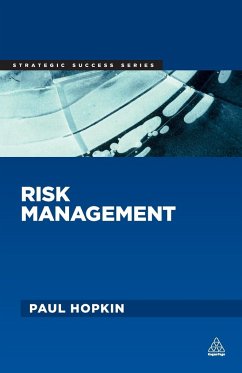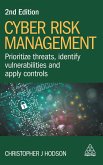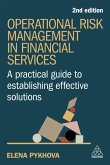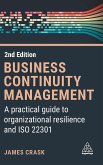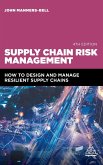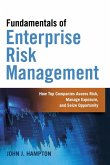Paul Hopkin
Risk Management
Paul Hopkin
Risk Management
- Broschiertes Buch
- Merkliste
- Auf die Merkliste
- Bewerten Bewerten
- Teilen
- Produkt teilen
- Produkterinnerung
- Produkterinnerung
Risk management is not just a topic for risk professionals. Managers and directors at all levels must be equipped with an understanding of risk and the tools and processes required to assess and manage it successfully. Risk Management offers a practical and structured approach while avoiding jargon, theory and many of the complex issues that preoccupy risk management practitioners but have little relevance for non-specialists. Supported by online templates and with real-life examples throughout, this is a straightforward and engaging guide to the practice and the benefits of good risk…mehr
Andere Kunden interessierten sich auch für
![Cyber Risk Management Cyber Risk Management]() Christopher J HodsonCyber Risk Management175,99 €
Christopher J HodsonCyber Risk Management175,99 €![Operational Risk Management in Financial Services Operational Risk Management in Financial Services]() Elena PykhovaOperational Risk Management in Financial Services154,99 €
Elena PykhovaOperational Risk Management in Financial Services154,99 €![Business Continuity Management Business Continuity Management]() James CraskBusiness Continuity Management184,99 €
James CraskBusiness Continuity Management184,99 €![Supply Chain Risk Management Supply Chain Risk Management]() John Manners-BellSupply Chain Risk Management208,99 €
John Manners-BellSupply Chain Risk Management208,99 €![Artificial Intelligence for Risk Management Artificial Intelligence for Risk Management]() Archie AddoArtificial Intelligence for Risk Management24,99 €
Archie AddoArtificial Intelligence for Risk Management24,99 €![Fundamentals of Enterprise Risk Management Fundamentals of Enterprise Risk Management]() John HamptonFundamentals of Enterprise Risk Management41,99 €
John HamptonFundamentals of Enterprise Risk Management41,99 €![Risk Management Maturity Risk Management Maturity]() Sylwia B¿kRisk Management Maturity31,99 €
Sylwia B¿kRisk Management Maturity31,99 €-
-
-
Risk management is not just a topic for risk professionals. Managers and directors at all levels must be equipped with an understanding of risk and the tools and processes required to assess and manage it successfully. Risk Management offers a practical and structured approach while avoiding jargon, theory and many of the complex issues that preoccupy risk management practitioners but have little relevance for non-specialists. Supported by online templates and with real-life examples throughout, this is a straightforward and engaging guide to the practice and the benefits of good risk management. Coverage includes: the nature of risk; the relevance of risk management to the business model; essential elements of the risk management process; different approaches to risk assessment; strategy, tactics, operations and compliance requirements; how to build a risk-aware culture; and the importance of risk governance. Online supporting resources for this book include downloadable templates including risk agenda, risk response and risk communication.
Hinweis: Dieser Artikel kann nur an eine deutsche Lieferadresse ausgeliefert werden.
Hinweis: Dieser Artikel kann nur an eine deutsche Lieferadresse ausgeliefert werden.
Produktdetails
- Produktdetails
- Verlag: Kogan Page
- Seitenzahl: 290
- Erscheinungstermin: 1. Mai 2013
- Englisch
- Abmessung: 216mm x 140mm x 16mm
- Gewicht: 368g
- ISBN-13: 9780749468385
- ISBN-10: 0749468386
- Artikelnr.: 36721404
- Herstellerkennzeichnung
- Libri GmbH
- Europaallee 1
- 36244 Bad Hersfeld
- gpsr@libri.de
- Verlag: Kogan Page
- Seitenzahl: 290
- Erscheinungstermin: 1. Mai 2013
- Englisch
- Abmessung: 216mm x 140mm x 16mm
- Gewicht: 368g
- ISBN-13: 9780749468385
- ISBN-10: 0749468386
- Artikelnr.: 36721404
- Herstellerkennzeichnung
- Libri GmbH
- Europaallee 1
- 36244 Bad Hersfeld
- gpsr@libri.de
Paul Hopkin is currently Technical Director at the Institute of Risk Management, having held the same role at the Association of Insurance and Risk Managers (AIRMIC) for nine years. He was previously Director of Risk Management for The Rank Group Plc and before that Head of Risk Management at the BBC. He is also the author of The Fundamentals of Risk Management (Kogan Page).
List of Figures
Preface
Acknowledgements
Introduction
Part I Risk agenda
Importance of the risk agenda
Scope of the risk agenda
Key messages for Part I
1 Relevance of the risk agenda
Definitions and types of risk
Compiling a risk description
Scope of risk management activities
Establishing the risk agenda
2 Drivers of risk management
Risk management drivers
Business development model
3 Features of risk management
Risk management principles
Proportionate risk management
Aligned risk management
Dynamic risk management
4 Planning the risk agenda
Comprehensive risk agenda
Embedded risk management
Achieving measurable benefits
Part I Review
Checklist
Case studies
Oxfam
Leicestershire County Council
ITV
Further reading
Part II Risk assessment
Importance of risk assessment
Scope of risk assessment
Key messages for Part II
5 Relevance of risk assessment
Purpose of risk assessment
Risk assessment techniques
Collecting information on risk exposures
SWOT and PESTLE evaluations
6 Analysing potential impact
Assessing potential impact
Risk magnitude and likelihood
Risk assessment considerations
Risk appetite and risk criteria
7 Evaluating anticipated consequences
Range of consequences to consider
Scope of risk assessments
Purpose of risk assessment
Risks to core business processes
8 Utilizing risk assessments
Recording the results of the risk assessment
Developing a risk action plan
Disruption to operations and loss control
Part II Review
Checklist
Case studies
Scottish Government
Cambridge NHS
Coventry Building Society
Further reading
Part III Risk response
Importance of risk response
Scope of risk response
Key messages for Part III
9 Relevance of risk response
Purpose of risk response
Options for responding to risks
Selection of risk response
Implementing appropriate controls
10 Designing risk controls
Selection of controls
Preventive and corrective controls
Directive and detective controls
Insurance as a control
11 Disaster recovery and business continuity
Preparing for disruption
Business impact analysis
Disaster recovery planning
Business continuity planning
12 Efficiency and effectiveness of controls
Selecting appropriate controls
Maintaining the risk action plan
Learning from controls
Part III Review
Checklist
Case studies
BBC
West Somerset Community College
BG Group
Further reading
Part IV Risk communication
Importance of risk communication
Scope of risk communication
Key messages for Part IV
13 Relevance of risk communication
Nature of risk communication
Risk management documentation
Risk information and risk training
Government risk communication
14 Risk architecture and protocols
Risk management manual
Risk roles and responsibilities
Risk management and committees
Developing risk protocols
15 Risk action plan
Designing a suitable risk register
Risk register and risk action plan
Risk communication protocols
Risk culture and risk maturity
16 Risk reporting
Internal risk communication
External risk reporting
Completing statutory risk reports
Part IV Review
Checklist
Case studies
NHS Direct
Morrisons
GSK
Further reading
Part V Risk governance
Importance of risk governance
Scope of risk governance
Key messages for Part V
17 Relevance of risk governance
Purpose of corporate governance
Scope of corporate governance activities
Risk and the three lines of defence
Governance and risk management
18 Providing risk assurance
Purpose of risk assurance
Sources of risk assurance
Nature of risk assurance reports
Challenging assurances offered
19 Governance of emerging risks
Nature of emerging risks
Responding to emerging risks
Examples of emerging risks
Challenges of emerging risks
20 Risk and stakeholder expectations
Identifying the range of stakeholders
Responding to stakeholder expectations
Stakeholder risk expectations
Part V Review
Checklist
Case studies
Heriot Watt University
Rexham plc
Interior Services Group
Further reading
Appendix 1: Risk management and Organate Foods
Appendix 2: Templates - Implementing a risk management initiative
Index
Preface
Acknowledgements
Introduction
Part I Risk agenda
Importance of the risk agenda
Scope of the risk agenda
Key messages for Part I
1 Relevance of the risk agenda
Definitions and types of risk
Compiling a risk description
Scope of risk management activities
Establishing the risk agenda
2 Drivers of risk management
Risk management drivers
Business development model
3 Features of risk management
Risk management principles
Proportionate risk management
Aligned risk management
Dynamic risk management
4 Planning the risk agenda
Comprehensive risk agenda
Embedded risk management
Achieving measurable benefits
Part I Review
Checklist
Case studies
Oxfam
Leicestershire County Council
ITV
Further reading
Part II Risk assessment
Importance of risk assessment
Scope of risk assessment
Key messages for Part II
5 Relevance of risk assessment
Purpose of risk assessment
Risk assessment techniques
Collecting information on risk exposures
SWOT and PESTLE evaluations
6 Analysing potential impact
Assessing potential impact
Risk magnitude and likelihood
Risk assessment considerations
Risk appetite and risk criteria
7 Evaluating anticipated consequences
Range of consequences to consider
Scope of risk assessments
Purpose of risk assessment
Risks to core business processes
8 Utilizing risk assessments
Recording the results of the risk assessment
Developing a risk action plan
Disruption to operations and loss control
Part II Review
Checklist
Case studies
Scottish Government
Cambridge NHS
Coventry Building Society
Further reading
Part III Risk response
Importance of risk response
Scope of risk response
Key messages for Part III
9 Relevance of risk response
Purpose of risk response
Options for responding to risks
Selection of risk response
Implementing appropriate controls
10 Designing risk controls
Selection of controls
Preventive and corrective controls
Directive and detective controls
Insurance as a control
11 Disaster recovery and business continuity
Preparing for disruption
Business impact analysis
Disaster recovery planning
Business continuity planning
12 Efficiency and effectiveness of controls
Selecting appropriate controls
Maintaining the risk action plan
Learning from controls
Part III Review
Checklist
Case studies
BBC
West Somerset Community College
BG Group
Further reading
Part IV Risk communication
Importance of risk communication
Scope of risk communication
Key messages for Part IV
13 Relevance of risk communication
Nature of risk communication
Risk management documentation
Risk information and risk training
Government risk communication
14 Risk architecture and protocols
Risk management manual
Risk roles and responsibilities
Risk management and committees
Developing risk protocols
15 Risk action plan
Designing a suitable risk register
Risk register and risk action plan
Risk communication protocols
Risk culture and risk maturity
16 Risk reporting
Internal risk communication
External risk reporting
Completing statutory risk reports
Part IV Review
Checklist
Case studies
NHS Direct
Morrisons
GSK
Further reading
Part V Risk governance
Importance of risk governance
Scope of risk governance
Key messages for Part V
17 Relevance of risk governance
Purpose of corporate governance
Scope of corporate governance activities
Risk and the three lines of defence
Governance and risk management
18 Providing risk assurance
Purpose of risk assurance
Sources of risk assurance
Nature of risk assurance reports
Challenging assurances offered
19 Governance of emerging risks
Nature of emerging risks
Responding to emerging risks
Examples of emerging risks
Challenges of emerging risks
20 Risk and stakeholder expectations
Identifying the range of stakeholders
Responding to stakeholder expectations
Stakeholder risk expectations
Part V Review
Checklist
Case studies
Heriot Watt University
Rexham plc
Interior Services Group
Further reading
Appendix 1: Risk management and Organate Foods
Appendix 2: Templates - Implementing a risk management initiative
Index
List of Figures
Preface
Acknowledgements
Introduction
Part I Risk agenda
Importance of the risk agenda
Scope of the risk agenda
Key messages for Part I
1 Relevance of the risk agenda
Definitions and types of risk
Compiling a risk description
Scope of risk management activities
Establishing the risk agenda
2 Drivers of risk management
Risk management drivers
Business development model
3 Features of risk management
Risk management principles
Proportionate risk management
Aligned risk management
Dynamic risk management
4 Planning the risk agenda
Comprehensive risk agenda
Embedded risk management
Achieving measurable benefits
Part I Review
Checklist
Case studies
Oxfam
Leicestershire County Council
ITV
Further reading
Part II Risk assessment
Importance of risk assessment
Scope of risk assessment
Key messages for Part II
5 Relevance of risk assessment
Purpose of risk assessment
Risk assessment techniques
Collecting information on risk exposures
SWOT and PESTLE evaluations
6 Analysing potential impact
Assessing potential impact
Risk magnitude and likelihood
Risk assessment considerations
Risk appetite and risk criteria
7 Evaluating anticipated consequences
Range of consequences to consider
Scope of risk assessments
Purpose of risk assessment
Risks to core business processes
8 Utilizing risk assessments
Recording the results of the risk assessment
Developing a risk action plan
Disruption to operations and loss control
Part II Review
Checklist
Case studies
Scottish Government
Cambridge NHS
Coventry Building Society
Further reading
Part III Risk response
Importance of risk response
Scope of risk response
Key messages for Part III
9 Relevance of risk response
Purpose of risk response
Options for responding to risks
Selection of risk response
Implementing appropriate controls
10 Designing risk controls
Selection of controls
Preventive and corrective controls
Directive and detective controls
Insurance as a control
11 Disaster recovery and business continuity
Preparing for disruption
Business impact analysis
Disaster recovery planning
Business continuity planning
12 Efficiency and effectiveness of controls
Selecting appropriate controls
Maintaining the risk action plan
Learning from controls
Part III Review
Checklist
Case studies
BBC
West Somerset Community College
BG Group
Further reading
Part IV Risk communication
Importance of risk communication
Scope of risk communication
Key messages for Part IV
13 Relevance of risk communication
Nature of risk communication
Risk management documentation
Risk information and risk training
Government risk communication
14 Risk architecture and protocols
Risk management manual
Risk roles and responsibilities
Risk management and committees
Developing risk protocols
15 Risk action plan
Designing a suitable risk register
Risk register and risk action plan
Risk communication protocols
Risk culture and risk maturity
16 Risk reporting
Internal risk communication
External risk reporting
Completing statutory risk reports
Part IV Review
Checklist
Case studies
NHS Direct
Morrisons
GSK
Further reading
Part V Risk governance
Importance of risk governance
Scope of risk governance
Key messages for Part V
17 Relevance of risk governance
Purpose of corporate governance
Scope of corporate governance activities
Risk and the three lines of defence
Governance and risk management
18 Providing risk assurance
Purpose of risk assurance
Sources of risk assurance
Nature of risk assurance reports
Challenging assurances offered
19 Governance of emerging risks
Nature of emerging risks
Responding to emerging risks
Examples of emerging risks
Challenges of emerging risks
20 Risk and stakeholder expectations
Identifying the range of stakeholders
Responding to stakeholder expectations
Stakeholder risk expectations
Part V Review
Checklist
Case studies
Heriot Watt University
Rexham plc
Interior Services Group
Further reading
Appendix 1: Risk management and Organate Foods
Appendix 2: Templates - Implementing a risk management initiative
Index
Preface
Acknowledgements
Introduction
Part I Risk agenda
Importance of the risk agenda
Scope of the risk agenda
Key messages for Part I
1 Relevance of the risk agenda
Definitions and types of risk
Compiling a risk description
Scope of risk management activities
Establishing the risk agenda
2 Drivers of risk management
Risk management drivers
Business development model
3 Features of risk management
Risk management principles
Proportionate risk management
Aligned risk management
Dynamic risk management
4 Planning the risk agenda
Comprehensive risk agenda
Embedded risk management
Achieving measurable benefits
Part I Review
Checklist
Case studies
Oxfam
Leicestershire County Council
ITV
Further reading
Part II Risk assessment
Importance of risk assessment
Scope of risk assessment
Key messages for Part II
5 Relevance of risk assessment
Purpose of risk assessment
Risk assessment techniques
Collecting information on risk exposures
SWOT and PESTLE evaluations
6 Analysing potential impact
Assessing potential impact
Risk magnitude and likelihood
Risk assessment considerations
Risk appetite and risk criteria
7 Evaluating anticipated consequences
Range of consequences to consider
Scope of risk assessments
Purpose of risk assessment
Risks to core business processes
8 Utilizing risk assessments
Recording the results of the risk assessment
Developing a risk action plan
Disruption to operations and loss control
Part II Review
Checklist
Case studies
Scottish Government
Cambridge NHS
Coventry Building Society
Further reading
Part III Risk response
Importance of risk response
Scope of risk response
Key messages for Part III
9 Relevance of risk response
Purpose of risk response
Options for responding to risks
Selection of risk response
Implementing appropriate controls
10 Designing risk controls
Selection of controls
Preventive and corrective controls
Directive and detective controls
Insurance as a control
11 Disaster recovery and business continuity
Preparing for disruption
Business impact analysis
Disaster recovery planning
Business continuity planning
12 Efficiency and effectiveness of controls
Selecting appropriate controls
Maintaining the risk action plan
Learning from controls
Part III Review
Checklist
Case studies
BBC
West Somerset Community College
BG Group
Further reading
Part IV Risk communication
Importance of risk communication
Scope of risk communication
Key messages for Part IV
13 Relevance of risk communication
Nature of risk communication
Risk management documentation
Risk information and risk training
Government risk communication
14 Risk architecture and protocols
Risk management manual
Risk roles and responsibilities
Risk management and committees
Developing risk protocols
15 Risk action plan
Designing a suitable risk register
Risk register and risk action plan
Risk communication protocols
Risk culture and risk maturity
16 Risk reporting
Internal risk communication
External risk reporting
Completing statutory risk reports
Part IV Review
Checklist
Case studies
NHS Direct
Morrisons
GSK
Further reading
Part V Risk governance
Importance of risk governance
Scope of risk governance
Key messages for Part V
17 Relevance of risk governance
Purpose of corporate governance
Scope of corporate governance activities
Risk and the three lines of defence
Governance and risk management
18 Providing risk assurance
Purpose of risk assurance
Sources of risk assurance
Nature of risk assurance reports
Challenging assurances offered
19 Governance of emerging risks
Nature of emerging risks
Responding to emerging risks
Examples of emerging risks
Challenges of emerging risks
20 Risk and stakeholder expectations
Identifying the range of stakeholders
Responding to stakeholder expectations
Stakeholder risk expectations
Part V Review
Checklist
Case studies
Heriot Watt University
Rexham plc
Interior Services Group
Further reading
Appendix 1: Risk management and Organate Foods
Appendix 2: Templates - Implementing a risk management initiative
Index

